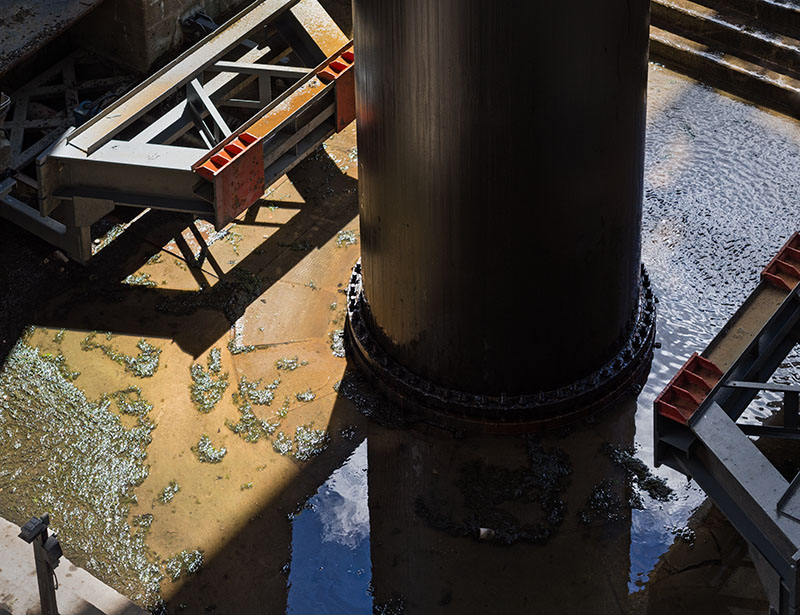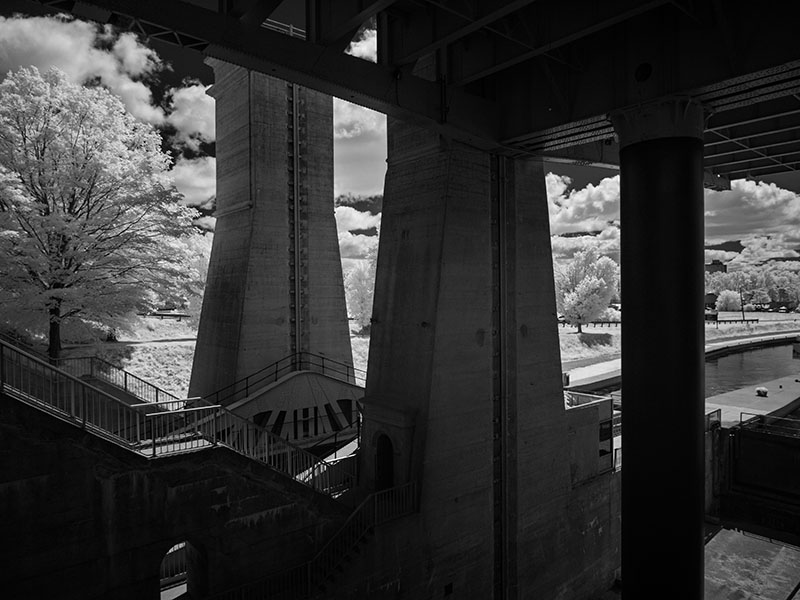This week's column by Ctein
Earlier this month, I was off photographing at the Peterborough Lift Lock with Christopher Sanderson and Michael Reichmann, using both my IR-converted Olympus Pen and my utterly conventional Olympus E-M5 (guess I can't call it the "OM-D" any longer). Quickly, I became acutely aware of a peculiarity that had been nagging at the back of my consciousness for some weeks.
I never have any problem photographing in several different media at the same time. I wrote about this some years ago, in "I Am The Camera...Or Is It The Other Way Around?" It doesn't matter to me what medium or format I'm using; when I pick up the camera I just naturally compose within the constraints of that tool.
I've always been a telephoto kind of guy. At various times I use everything from extreme wide-angle to extreme telephoto, but moderate telephoto fits best with my mind's eye. The 45mm Olympus lens is my perfect lens. If I were forced to work with one and only one lens, it would be that. It's the lens I always have mounted on the E-M5 when I'm carrying around just the camera and one lens. This is true whether I'm photographing day or night, nature or urban, color or B&W, my "vision" doesn't much change with the medium.
...Except for this: when I'm photographing narrow-band deep infrared, it's different! Then, the right field of view for my mind's eye seems to be strong wide-angle. The Olympus 12mm lens is a lens I'm not particularly fond of for regular work; it just usually doesn't fit with the way I see. Yet in the deep IR it seems to be just about perfect.
Now what's with that?!
As an experiment I tried swapping lenses between the two cameras. Nope. The 45mm on the IR Pen wasn't especially inspiring. Oh, sure, if I worked hard enough, I could find good compositions. I can find good compositions with anything. But mostly it felt like I was forcing myself to see that way, the same way the 12mm usually feels for my regular photography. There's a real strong preference that's not in my imagination, and it's the first time I've ever found myself instinctively drawn to strong wide-angle lens compositions.
I repeat. What's with that?!
Figures 1 and 2 are typical of the work I did that day, with the 12mm on the IR Pen and the 45mm on the E-M5. (A gentle reminder: illustrations illustrate—they do not prove. If you like one of these photos much better than the other, well, that's you. Me, I like them equally well, and this is about me. So, no judgement-passing, please?)
Understand, the question isn't why I like telephoto lenses normally, that's just what it is. The question is what's so different (and why!) when I pick up the IR Pen? I mentioned this to Chris and Michael, and Chris trotted out several quarter-baked notions:
Hypothesis 1: Conventional color and panchromatic B&W are very rich media, tone and color-wise—lots and lots of visual information in every square degree. I don't feel the need for wide angle because I've got plenty of visual content; more may even confuse the picture by trying to say too much at once. Narrow-band deep IR provides much less visual information per square degree, so I can include more material before hitting the "this picture is full" point.
Hypothesis 2: Panchro B&W and color are the normal ways we see the world. Deep narrow band IR is an alien world of novel and unfamiliar information, so I want to grab as much of it as I can in a single photograph, to satisfy my visual curiosity and provide context for new understanding.
Hypothesis 3: I'm simply greedy, sensation-wise. I like complicated photographs. The low info density of the IR has me saying (compositionally), "More, more, I'm still hungry!" which the wide angle provides.
Are any of these right, in part or in whole? I have no idea; I'm not that insightful.
So I tossed the question out to TOP's Brain Trust and something even more interesting and unexpected popped up. Different ones of us were using two quite distinct modes of seeing/composing:
Some of us, including me, pick up a camera and the world turns into Flatland (vis my earlier column). Well, Flatland with layers, he said oxymoronically. The Z-axis is entirely irrelevant to my compositional sense. I don't pay any attention to how elements of the composition are separated from each other by distance. It's only their relationship in the X-Y plane that affects my compositional sense.
Others of us engage in what I would describe as volumetric seeing. They do see the three-dimensional relationships between objects and for them the act of composition is about how they render those three-dimensional relationships in a two-dimensional plane. That Z-axis is very important to them, conceptually. Entirely opposite of me and my ilk.
And what does all of this mean? I do not have the foggiest idea. I just find it fascinating.
©2013 by Ctein, all rights reserved
Ctein's conundra (is that a word?) appear on TOP on Wednesdays.
Links in this post may be to our affiliates; sales through affiliate links may benefit this site.
(To see all the comments, click on the "Comments" link below.)
Featured Comments from:
ben ng: "Funny, I'm the same, i.e. when using IR I tend to use more wide-angle compositions. The exception is when shooting performance or portraits.
I see it as using different musical instruments. I take different pictures when I shoot B&W than when I shoot color; when I shoot IR there seems to be a more emotional response...see the results in my flickr link...!
"I just find changing things very refreshing."




